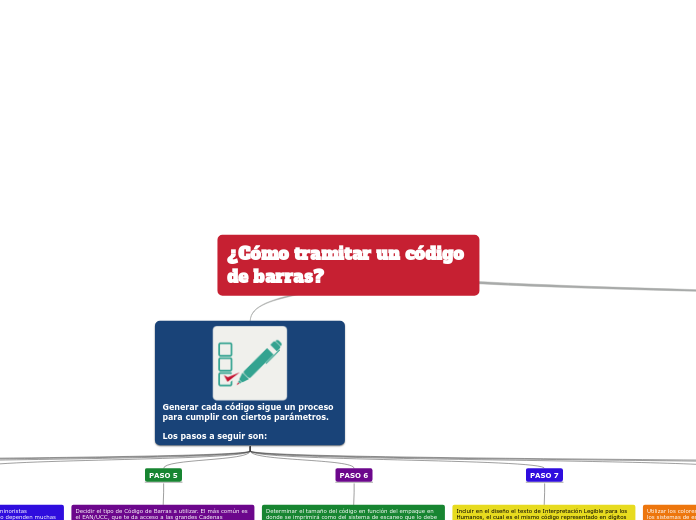¿Cómo tramitar un código de barras?
Type in the name of the multiple-perspectives text.
Example: Bridge to Terabithia by Katherine Paterson
La entidad mundial que los emite y garantiza que sean únicos es GS1 Global, y debes registrarte como miembro de la asociación para que te sea asignado un código de identificación como empresa. GS1 México es el capítulo en nuestro país responsable de gestionar los códigos en nuestro país.
Generar cada código sigue un proceso para cumplir con ciertos parámetros.
Los pasos a seguir son:
Identify an important issue from the text that is being presented from different angles. Type it in.
Example: Jesse's drawing talent.
PASO 10
Verificar que la imagen del código sea legible antes de mandar producir un sinnúmero de empaques que pudieran terminar en la basura y significar grandes pérdidas para tu negocio si el símbolo no tiene la calidad de diseño o impresión requerida.
PASO 9
Ubicar el código en el diseño de manera que no se corra el riesgo de que arrugas, bordes o pliegues en el mismo impidan su lectura.
PASO 8
Utilizar los colores correctos para permitir una fácil lectura por los sistemas de escaneo. Lo común son barras negras sobre fondo blanco, pero se pueden usar colores oscuros para las columnas sobre un fondo de color claro.
Subtopic
PASO 7
Incluir en el diseño el texto de Interpretación Legible para los Humanos, el cual es el mismo código representado en dígitos y colocado debajo de las barras.
PASO 6
Determinar el tamaño del código en función del empaque en donde se imprimirá como del sistema de escaneo que lo debe reconocer.
PASO 5
Decidir el tipo de Código de Barras a utilizar. El más común es el EAN/UCC, que te da acceso a las grandes Cadenas Comerciales y es solicitado en la mayoría de los mercados de exportación.
PASO 4
Decide on the fourth point of view
Type in the name of the last character whose perspective on the issue you are going to present.
Example: Leslie Burke, Jesse's new next-door neighbor, and best friend.
Elegir el método de escaneo (en tiendas minoristas generalmente es omnidireccional). De esto dependen muchas de las especificaciones que debe cumplir el Código de Barras impreso, como su tamaño y ubicación en el empaque
Point of view
Type in a relevant quote that highlights the character's point of view. Try to follow a citation format: author's name, chapter, and page.
Example: I can't get the poetry of the trees,' he said. She nodded. Don't worry,' she said. You will someday. He believed her.' (Paterson, 4. 24)
How is the viewpoint introduced in the story?
Choose an answer:
First person point of view - using the personal pronouns 'I' or 'we'Second person point of view - using the personal pronoun 'you'Third person point of view - using the third-person pronouns 'he', 'she' and 'they'Omniscient point of view - an all-seeing observer tells the story
PASO 3
Whose character does the third point of view belong to?
Type in his/her name.
Example: Mr. Aarons, Jesse's father.
Seleccionar si tu Código de Barras incluirá información estática, que nunca cambiará, o dinámica, pues esto influirá en la elección del proceso de impresión.
What does the character think, say or do that suggests their perspective on the issue?
Type in a quote and try to maintain the citation format.
Example: 'He would like to show his drawings to his dad, but he didn't dare. (...) He'd thought his dad would be pleased. He wasn't. What are they teaching in that damn school? he had asked.' (Paterson, 2.8)
What kind of narration introduces the viewpoint?
Choose an answer:
First person point of view - using the personal pronouns 'I' or 'we'Second person point of view - using the personal pronoun 'you'Third person point of view - using the third-person pronouns 'he', 'she' and 'they'Omniscient point of view - an all-seeing observer tells the story
PASO 2
Decide on the second point of view
Name the character (it can either be the main character or one of the supporting characters) whose point of view you are presenting.
Example: Miss Edmunds, Jesse's music teacher.
Asignar un número de identificación a cada uno de tus productos.
Type in a quote that points out the character's position about the issue.
Try to follow a citation format: author's name, chapter, and page.
Example: 'She said he was unusually talented, and she hoped he wouldn't let anything discourage him.' (Paterson, 2. 8)
How is the viewpoint introduced in the story?
Choose an answer:
First person point of viewSecond person point of viewThird person point of viewOmniscient point of view
PASO 1
Decide on the first point of view you are going to present.
Type in the name of the character (it can either be the main character or one of the supporting characters) whose point of view belongs to.
Example: Jesse Oliver Aarons, Jr., the main character of the novel, a fifth-grader living in a rural Southern area.
Obtener tu prefijo como empresa, el cual incluye el identificador del país donde operas, en el caso de México es 750, y el número asignado por GS1 a tu negocio.
Type in a relevant quote that highlights the character's point of view towards
Generar cada código sigue un proceso para cumplir con ciertos parámetros.
Los pasos a seguir son:.
Try following a citation format: author's name, chapter, and page.
Example: 'Jesse drew the way some people drank whiskey. (...) Lord, he loved to draw. (...) When he was in first grade, he told his father that he wanted to be an artist when he grew up.' (Paterson, 2. 7)
.
What type of narration introduces the viewpoint?
Choose an answer:
First person point of view - using the personal pronouns 'I' or 'we'Second person point of view - using the personal pronoun 'you'Third person point of view - using the third-person pronouns 'he', 'she' and 'they'Omniscient point of view - an all-seeing observer tells the story









